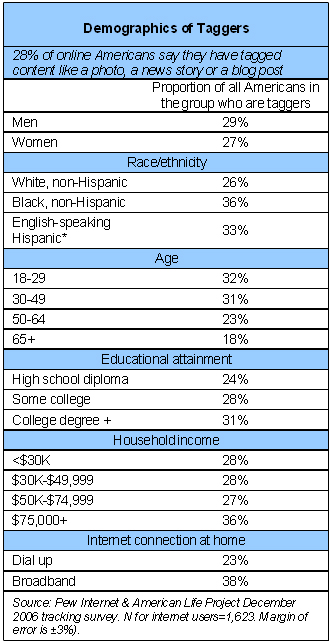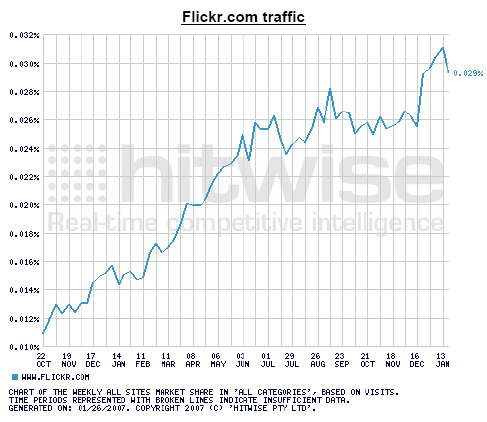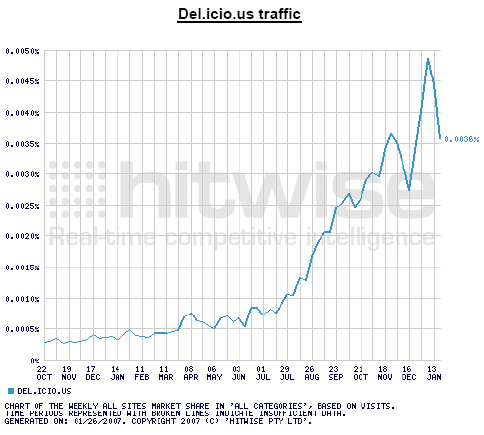Forget Dewey and His Decimals, Internet Users are Revolutionizing the Way We Classify Information – and Make Sense of It
Just as the internet allows users to create and share their own media, it is also enabling them to organize digital material their own way, rather than relying on pre-existing formats of classifying information. A December 2006 survey by the Pew Internet & American Life Project has found that 28% of internet users have tagged or categorized content online such as photos, news stories or blog posts. On a typical day online, 7% of internet users say they tag or categorize online content.
These people said “yes” to the following question: “Please tell me if you ever use the internet to categorize or tag online content like a photo, news story, or a blog post.” The wording was designed to capture the growing use of tagging on sites such as http://del.icio.us/ (a site for sharing browser bookmarks), http://www.flickr.com/ (a photo sharing site), http://youtube.com/ (a video sharing site) and http://technorati.com/ (the blog search engine).
Tagging is gaining prominence as an activity some classify as a Web 2.0 hallmark in part because it advances and personalizes online searching. Traditionally, search on the web (or within websites) is done by using keywords. Tagging is a kind of next-stage search phenomenon – a way to mark, store, and then retrieve the web content that users already found valuable and of which they want to keep track. It is, of course, more tailored to individual needs and not designed to be the all-inclusive system that Melvil Dewey tried to create with his decimal-based scheme for cataloguing library materials.
In a book to be released on May 1, Everything Is Miscellaneous: The Power of the New Digital Disorder (Times Books), David Weinberger, a fellow at Harvard’s Berkman Center for Internet & Society and a prominent blogger, describes how people are putting ideas, information and knowledge together now that the digital age has encouraged alternatives to organizing information from hierarchical systems like the Dewey Decimal method. An online interview with Weinberger is featured at the end of this article.
How tagging works
This is the first time the Project has asked about tagging, so it is not clear exactly how fast the trend is growing. Tagging is one of the emerging Web 2.0 activities around which there is debate about what should be officially counted as tagging. That is, what sets tagging apart as a distinct activity, say, from creating a traditional browser bookmark?
To add to the complexity of the issue, there are probably people who have created a tag who would use a different term for the activity. For example, some sites invite users to apply “labels” to content and don’t use the word “tag.” Google’s tagging feature is actually called “bookmark,” though applies the principles of tagging. Other sites enable tagging so effortlessly that people might not be conscious they are doing it.
Tagging is the process of creating labels for online content. The mechanics are simple on most tag-centered websites and there is an Appendix to this report that links to some sites that cover more fully the mechanics of tagging.
After creating an account on a site like Flickr.com you can upload your photos to the site and then apply labels to the pictures that make sense to you – for instance, labeling a photo of a sunset as “sunset.” Once the labels are applied, anyone using Flickr’s search bar who types in “sunset” can find yours among the other pictures that are similarly named.
You can also search the site using keywords and when you find photos posted by others that you like enough to want to retrieve later, you can apply your own tags to them. That might mean that you call someone else’s picture “sunset” even though he originally labeled it “clouds.”
Then, from any internet-connected computer you go back to the search box on Flickr.com and type in the labels you created and find all the material you have tagged – both yours and the material from others that you have labeled your own way. Thus, typing in “sunset” will yield search results that take you to the pictures you tagged that way.
Not only can tags be personally useful to people who want easier ways to retrieve information that appealed to them, but tags also have a social dimension. Your tags on Flickr are added to the millions of other labels on the site and that allows Flickr to organize information better for other searchers who use those keywords – making this a classic example of bottom-up building of categories instead of top-down imposition of categories.
Your tags also allow Flickr to highlight the most popular listings. These “tag clouds” illustrate the material that was tagged by others and tag sites usually showcase the most popular tags by increasing the font size and boldness of the type as Flickr does here: http://www.flickr.com/photos/tags/ .
Who the taggers are
Taggers look like classic early adopters of technology. They are more likely to be under age 40, and have higher levels of education and income.
Taggers are considerably more likely to have broadband connections at home, rather than dial-up connections. Men and women are equally likely to be taggers, while online minorities are a bit more likely than whites to be taggers.
The act of tagging is likely to be embraced by a more mainstream population in the future because many organizations are making it easier and easier to tag internet content. For instance, Gmail users can label their email content and Amazon users can apply the labels of their choosing to books and other published material.
Yahoo has added web applications that make it easy to tag and store web pages. Some sites have buttons on their web pages that allow their content to be stored on tagging sites with a simple click of a mouse.
There are even reports that some web users now have made tagging sites their home page, making these sites at least nominal competitors to big media companies that hope users will start their online experiences on their main page.

Tagging sites are getting more popular
Data from Hitwise, the web-tracking firm, show that tagging sites like Flickr and del.icio.us have gained in popularity as internet users become aware of them.
The data are presented as a percentage of all web traffic.

Del.icio.us is a site where people can tag their website bookmarks and, again, share their tags with others.

Why Tagging Matters: An Interview with David Weinberger
In his upcoming book, Everything Is Miscellaneous: The Power of the New Digital Disorder, Weinberger describes how radical it is for people to move away from hierarchical classifications of information like the Dewey Decimal System to individually- and group-arranged systems.
In Melvil Dewey’s world, all information is divided into ten major topical categories that might have made perfect sense to well-educated Westerners who shared Dewey’s frames of reference, but perhaps not to others. For instance, Dewey assigned the 800-899 block of numbers to literature and then doled out numbers 800-889 to American, European and classical languages. Thus, he squeezed every other bit of literature into the 10 remaining digits. Among other things, that means Russian literature did not even get its own whole number. It comes under 891.7, amidst East Indo-European and Celtic literatures.
It was also perfectly logical to Dewey that he list material relating to pets in the “technology” block of numbers in the 600s. Here’s how he worked that out:1

In the 21st Century world of user-generated categories and meaning, this is not perhaps as useful or sensible as it once was. David Weinberger has thought through the many ways tagging changes people’s relationship to information and each other. So, I traded emails with him on the subject and here’s the result:
Q: What started the current interest in tagging?
[in 2003]
But the nerve was there, ready to be struck, because of two factors:
First, tagging lets us organize the vastness of the Web — and even our email, as Gmail has shown — using the categories that matter to us as individuals. You may want to tag, say, a Stephen King story as “horror,” but maybe to me it’s “ghost story” and to a literature professor it’s “pop culture.” Tagging lets us organize the Net our way.
Second, tagging is social. Tags used to be called “keywords,” and they’ve been with us for a long time. But only recently have we been making them public. That has big effects. By searching for a tag we can find material others have discovered ahead of us: At Amazon’s “most popular tags” page, (http://www.amazon.com/gp/tagging/cloud/ref=tag_sr_nss/103-6276287-3099815) a search for things tagged “horror” turns up almost three thousand books and movies.
Tagging also allows social groups to form around similarities of interests and points of view. If you’re using the same tags as I do, we probably share some deep commonalities.
And, by looking over the public field of tags, we can see which tags are most frequently used and how they relate. Those patterns are called “folksonomies” — it’s a play on the word “taxonomies.” Folksonomies reveal how the public is making sense of things, not just how expert cataloguers think we ought to be thinking.
Q: Why do you think Internet users are drawn to tagging?
Weinberger: It’s really useful. Compare your traditional computer system to organize your digital photos to using a tagging system. Instead of having to stick a photo into a single folder — say, “trips 2006” — you can easily tag it as “Italy,” “anniversary,” “sunset,” “mountains,” and “no kids.” You can assemble instant virtual albums of all your anniversary photos, or all your photos of all your trips to Italy, etc.
There’s an altruistic appeal to tagging as well. Tagging at public sites can give you a sense that you’re adding to a shared stream of knowledge. At del.icio.us, or other such sites, tag a page “robotics” and you know that it’s automatically added to the list of pages tagged that way, so anyone else interested in that topic can find it.
Q: So, there are benefits beyond the individual.
Weinberger: Absolutely. Maybe the most interesting thing about tagging is that we now have millions and millions of people who are saying, in public, what they think pages and images are about. That’s crucial information that we can use to pull together new ideas and information across the endless sea we’ve created for ourselves.
Q: Does tagging create problems?
Weinberger: What doesn’t? Tags work because they’re so simple, but because they’re so simple, they can be ambiguous. The tag “roman,” for example, might refer to an Italian fountain, the director Roman Polanski, or the French word for “novel.” So, there’s a possibility for misunderstanding. And if you search for photos tagged “San Francisco,” you may not see photos tagged “sf” or “Golden Gate.” So, if you need to find everything about a topic, you often can’t rely on tags.
More broadly, some worry that folksonomies can be a type of “tyranny of the majority,” in which the prevalent group’s way of thinking about the world overwhelms the local and the quirky. That’s something to watch out for, but by analyzing tag sets we can also build a tag thesaurus that knows that the tag “roman” may be equivalent to the tag “novel” in some circumstances.
Q: What’s the future of tagging?
Weinberger: Because it’s useful when there’s lots of information and the information is truly meaningful to individuals, it’ll be adopted more and more widely. But we’re also going to invent new ways to harvest tagging. Flickr, for example, is already able to cluster photographs by subject with impressive accuracy just by analyzing their tags, so that photos of Gerald Ford are separated from photos of Ford Motor cars. We’ll also undoubtedly figure out how to intersect tags with social networks, so that the tags created by people we know and respect have more “weight” when we search for tagged items. In fact, by analyzing how various social groups use tags, we can do better at understanding how seemingly different worldviews map to one another.




